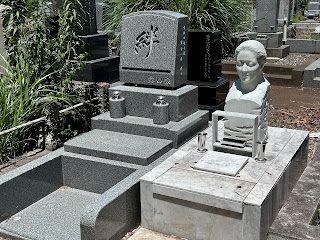Special Education Reflections
The first two shots are from the Tamacho Cemetery. The bottom shot is from one of my favorite places, the Jokyu-ji Temple.
As I prepare for my meeting with the American School folks on Monday, I have been reflecting on my past experiences. What lessons have I learned from that work? How can I keep growing as a teacher and as a human being?
Going into my special education career, I thought I had plenty of patience. However, boy did that work ever put my patience to the test! I think one of the lessons I learned is to keep my mouth shut and take a break when students push my buttons. I was raised with a "my way or the highway" mentality. That does not work very well when working with struggling students!
Fortunately, as I kept doing this work, I learned to be more patient and more accepting of the trials and tribulations of student behaviors. I learned that in most cases, the student and I could take a break and then deal with the behavior when we had both had the chance to calm down and think objectively.
One of the best pieces of advice I received was from my cooperating teacher for my student teaching experience. She said that I should always remember that special education students need more instruction and more practice than their peers, because their skills are behind those of their regular education peers. Easier said than done! The challenge is that those special education students do not necessarily want to put in the extra time and effort!
What seems so simple is not so simple! In the best of all worlds, the special education students would have a "growth mindset" and would willingly put in the extra time and effort to play catch-up with their regular education peers. Realistically speaking, the opposite is oftentimes the case. The special education students can resent the extra attention and then push back against the extra help.
I learned that every student is different. Each student has a different capacity for focusing and putting in the effort and the work. We can strive to push students to do their best. However, we have to be sensitive to student capacity at any given time. If we push too hard at the wrong time, the students shut down and we get nowhere or we even go backwards!
This process is particularly challenging for a high-achiever like me! I just have to remember that each student is different. It is imperative for me to listen to each student. I can then gauge what the student is capable of doing at that moment in time. I can also gauge how hard I can push that student at that moment in time.
Given that I will undoubtedly continue to make my fair share of mistakes, it never hurts to say, "I am sorry." It never hurts to take responsibility for my mistakes and for me to own those mistakes. Teachers are human. Students appreciate and respond well to these kinds of examples and what it means to "be human."
I have always sensed the importance of "never giving up on a student." My special education experiences really hammered home the significance of that attitude. For one thing, in public education in the United States, schools have an obligation to provide school services to all students. We have no choice but to do our best for every student. The corollary of that is that we should never ever give up on any student. It may take twenty five different approaches. It may take twenty five different strategies. In most cases, one of those is going to work and is going to make a difference in the student's life.
I think one of the best concepts in education is that of "making thinking visible." One of the ways I do that is to ask a student questions using a response scale of 1-10. "On a scale of 1-10, how motivated are you to be successful in a given class?" 10 is high motivation and 1 is low motivation. "On a scale of 1-10, how confident are you that you can be successful on this assignment or in this class?"
I have found that it does not work very well to just tell a student, "this work and this class are important, so suck it up and get the work done!" While there may be some truth to that approach, it does not specifically address the roadblocks for the student. What is causing those roadblocks? Does the student even understand the assignment guidelines and requirements? What is the student's current capacity for doing work? Would another time be better? Has the student had enough to eat? Enough sleep? Life at home?
There are so many factors that can interfere with student success. My job is to work with the student to identify those factors and then to make a plan that gives the student the greatest opportunity to get to the finish line. Patience, persistence, support, and a never-ending belief in the students will make a big difference!
One of the things I am most proud of is that in 14 years of working in special education at North Eugene High School, I never missed a day due to being sick. I have always taken good care of myself. In addition, I wanted to be there every day for my students so I could do anything and everything I could to help them. I wanted my students to know that we are in this world together, and that I've got their backs!






Hi Roy, What wonderful lessons learned in your years of teaching in the world of special education! The American School would be blessed to have you on their team! Love and hugs, Ty
ReplyDeleteThanks Ty! Love, Roy
DeleteHi Bob, I feel like I am in Japan as well as you. Your blog is wonderful. The American school staff and students will love you. We sure miss you at North. The new school, (dubbed by me as the Double N Ranch) isn't and won't be the same without you. I miss you, my friend.
ReplyDeleteI miss you too! Thanks! Bob
Delete